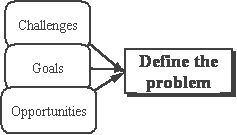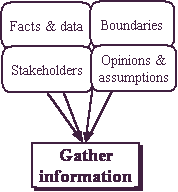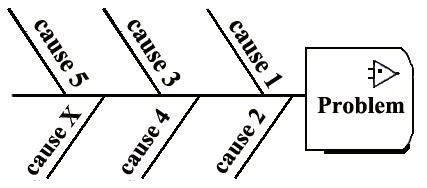Kiosk
To design is to communicate clearly by whatever means you
can control or master.
Milton Glaser
1929 - 3020 American designer |
Problem solving series
1. Defining the problem/
gathering information

Define the Problem
What prevents you from reaching
your goal?
You may need to state the problem in broad terms since the exact problem may not be obvious.
- you may lack information to define it
- you can confuse symptoms with underlying causes
Prepare a statement of the problem and find someone you trust to review it and to talk it over. If the problem is a job situation, review it with your supervisor or the appropriate committee or resource.
Consider these questions:
- What is the problem?
- Is it my problem?
- Can I solve it? Is it worth solving?
- Is this the real problem, or merely a symptom of a larger one?
- If this is an old problem, what's wrong with the previous solution?
- Does it need an immediate solution, or can it wait?
- Is it likely to go away by itself?
- Can I risk ignoring it?
- Does the problem have ethical dimensions?
- What conditions must the solution satisfy?
- Will the solution affect something that must remain unchanged?
Causes!
When problem solving, identify the causes of the problem in order to solve it.
- Identify causes of your problem
Look at the current situation, rather than its history
Do not consider the "trouble" it creates whether now or in the future. - List and organize the causes of the problem
Fishi-kawa! Ishikawa diagrams! Fishbone diagrams! *
Similar to the practice of concept mapping and brainstorming,
place each
"cause" along a line that ends in a box identifying a problem
creating your
very own fishbone diagram.
At the beginning brainstorm and identify
all the possible causes.
One strategy is to use post-it notes
for each cause,
then paste them into your "graph" along the "spine" for a
visual representation,
either on a whiteboard, flipchart, or other large
surface that can be modified.
If some causes relate to others, you can
develop layers connecting and extending out from the first rays. As you
develop your diagram, arrange the causes toward the fishhead/problem to indicate importance.
Identify/map all the
causes before considering solutions to the problem.
What are examples of causes of the problem?
- People
Are there enough participants to help?
Are the participants' skills adequate?
Are some participants perceived as not helpful? - Resources
Are there enough, for example funding?
Are some not identified?
Are some not used effectively, or mis-placed? - Environment
Is it conducive to problem solving? Is there too much stress?
Is the power structure (administration or line of authority) supportive?
Is the power structure (administration or line of authority) aware of the problem? - Processes, procedures and rules
Are they understood, or badly defined?
Are they perceived as an obstacle? - Vocabulary/terminology/concepts
Is there an agreed-upon vocabulary, and understanding of their meanings and definitions?
Are some "hidden"?
Working with the diagram:
- Consider all the causes and rank them in importance
either on their post-its, or by circles with numbers etc. - Examine relationship
Drop some causes to secondary levels, or off the chart to indicate irrelevance.

Gathering Information
Stakeholders
Individuals, groups, organizations
that are affected by the problem, or its solution.
Begin with yourself. Decision makers and those close to us
are very important to identify.
Facts & data
- Research
- Results from experimentation and studies
- Interviews of "experts" and trusted sources
- Observed events, past or present, either personally observed or reported
Boundaries
The boundaries or constraints of the
situation are difficult to change. They include lack of
funds or other resources. If a solution is surrounded by too
many constraints, the constraints themselves may be the
problem.
Opinions and Assumptions
Opinions of decision
makers, committees or groups, or other powerful groups will
be important to the success of your decision. It is
important to recognize truth, bias, or prejudice in the
opinion.
Assumptions can save time and work since is
often difficult to get "all the facts." Recognize that some
things are accepted on faith. Assumptions also have a risk
factor, must be recognized for what they are, and should be
discarded when they are proven wrong.

 Website overview:
Kiosk guides for learning are a freely accessible educational environment that offers strategies to recognize and realize learning objectives. We accept individual differences without regard to ability and creed; sexual and affectional orientation; caste, tribal and national affiliation; individual, familial and collective history. Our suggestions should be thoughtfully considered for appropriateness and guidance to your situation, relying on elders, mentors, cohorts and/or professionals to achieve learning objectives and outcomes.
Website overview:
Kiosk guides for learning are a freely accessible educational environment that offers strategies to recognize and realize learning objectives. We accept individual differences without regard to ability and creed; sexual and affectional orientation; caste, tribal and national affiliation; individual, familial and collective history. Our suggestions should be thoughtfully considered for appropriateness and guidance to your situation, relying on elders, mentors, cohorts and/or professionals to achieve learning objectives and outcomes.